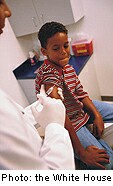
THURSDAY, April 29 (HealthDay News) — Apparently spurred by concerns about the recently discovered H1N1 swine flu virus, a record number of Americans — especially children and younger adults — got seasonal flu shots during the just-concluded flu season, U.S. health officials reported Thursday.
The increases in seasonal flu vaccinations — which did not offer protection against H1N1 flu — were largely driven by public programs instituted by the U.S. Centers for Disease Control and Prevention to get children and others to receive a seasonal flu shot, as well as the H1N1 vaccine. For the first time, children 5 to 18 were encouraged to get a flu shot this past flu season, CDC officials reported in the April 30 issue of the agency’s Morbidity and Mortality Weekly Report.
CDC officials said the 2010-2011 seasonal flu shot will include a component to protect against the H1N1 flu. Unlike traditional seasonal flu, the H1N1 flu — first identified last spring — strikes children and young adults harder than older adults.
“We are hopeful that those who were vaccinated this year will come back and get vaccinated for next season’s flu,” said study co-author Gary Euler, who’s with the CDC’s National Immunization Program.
Vaccination rates for the 2009-2010 flu season varied state-to-state, particularly among children. Coverage of children averaged 40 percent, compared to 24 percent for the 2008-2009 flu season.
Rates remained stable among recommended adult age groups: 36 percent for people 18 to 49 years of age with high-risk conditions, 45 percent for people 50 to 64, and 68 percent for people 65 and older, the report found.
Among younger adults who did not have high-risk conditions, vaccine coverage averaged 28 percent, seven points higher than last year, the researchers noted.
Euler said that school-based vaccination clinics were particularly effective in increasing vaccination rates among children. And, he added, “if the H1N1 vaccine had been available earlier more people would have been vaccinated.”
Next year will mark the first year when a flu shot is recommended for all Americans, which should lead to even higher vaccination rates, Euler said.
Infectious disease expert Dr. Marc Siegel, an associate professor of medicine at NYU Langone Medical Center, said the 2009-2010 flu season “ended up being a milder flu season than usual, by a long shot, because the H1N1 pandemic flu crowded out the seasonal flu.”
Siegel also pointed to the higher rates of vaccination among children, who, he said, are “super spreaders” of flu. “We ought to be vaccinating every child,” he added.
Siegel said that vaccinating children also protects older adults by limiting potential transmission of the disease. Older people, particularly seniors, are at heightened risk of complications and death from seasonal flu.
Another report in the same issue of the MMWR said that a new flu vaccine containing four times the amount of antigen has been licensed for use in people 65 and older.
Whether this stronger vaccine will improve the immune response of older people isn’t known, the CDC said. The agency’s Advisory Committee on Immunization Practices is waiting for data on the vaccine’s effectiveness before recommending its use.
Siegel said this vaccine could be very useful for some older patients.
“Basically, the elderly end up with less immunity,” he said. “The older you get and the more infirmed you get and the more chronic illnesses you have, the less your overall immunity to flu is.”
Good candidates for the new vaccine would include people with chronic conditions, such as diabetes and respiratory disorders, including chronic obstructive pulmonary disease (COPD), as well as people in hospitals and nursing homes, Siegel said.
More information
To learn more about seasonal flu, visit the U.S. Centers for Disease Control and Prevention.

